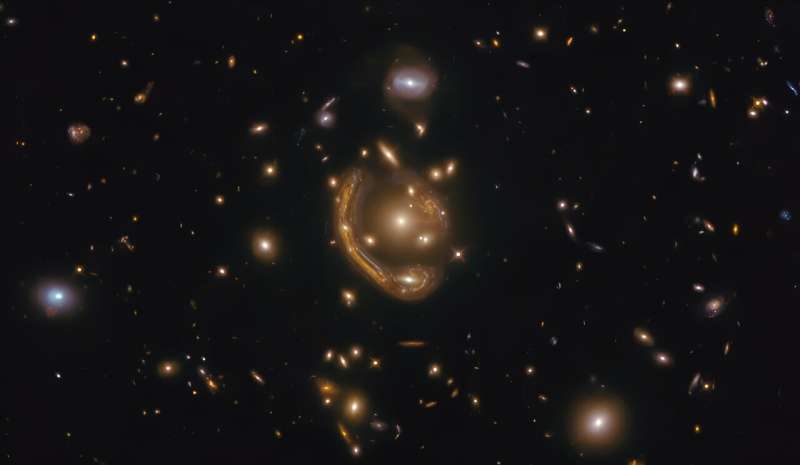This article has been reviewed according to Science X's editorial process and policies. Editors have highlighted the following attributes while ensuring the content's credibility:
fact-checked
preprint
trusted source
proofread
Can there be double gravitational lenses?

If you, like me, have used telescopes to gaze out at the wonders of the universe, then you too may have been a little captivated by the topic of gravitational lensing. Think about it: how cool is it that the very universe we are trying to explore is actually providing us with telescopes to probe the darkest corners of space and time?
The alignment of large clusters of galaxies is the usual culprit whose gravity bends distant light to give us nature's own telescopes, but now part-time theoretical physicist Viktor T Toth poses the question, "Can there be multiple gravitational lenses lined up and can they provide a 'communication bridge' to allow civilizations to communicate?"
You might have heard of Albert Einstein. In his general theory of relativity, he describes how the presence of matter can distort space around them. The famous analogy of placing a bowling ball at the center of a large rubber sheet causes a dip centered around the mass of the bowling ball. Any object rolling past the ball would find itself traveling through "curved space" and, therefore, find its path to be altered. This very concept is used successfully by space mission planners to adjust the trajectory of spacecraft exploring the solar system.
The same concept applies to light as it passes by massive objects like galaxy clusters and is the principle behind the gravitational lens. The first evidence of light being deflected by a massive object was performed in 1919 by Arthur Eddington and Frank Watson Dyson during a total solar eclipse. Gravitational lenses entered the scene 60 years later when they were first observed in 1979 by Dennis Walsh, Bob Carswell, and Ray Weymann using the 2.1m telescope at the Kitt Peak National Observatory.
In a fascinating paper authored by Toth and posted to the arXiv preprint server, he explores the possibility that multiple gravitational lenses might provide extra amplification of light to provide a communication bridge between distant civilizations.
In a conventional gravitational lens, a large mass—such as a cluster of galaxies—sits between a more distant object and the Earth. As the light travels from the distant object, it is bent around the galaxy cluster, providing a lensing effect to astronomers on Earth, allowing them to a) study the distribution of matter in the lensing cluster but also to observe the more distant object a little more easily. Toth proposes that, just like a conventional telescope that uses multiple lenses, a multiple gravitational lens could provide even more amplification than a single system.
Toth explores combinations of multiple gravitational lenses using a variety of methods but focuses (sorry) attention on a two-lens system (so-called gravitational lens bridge), which is aligned along the central axis of the system, but found no advantages and no additional signal amplification over the results from a single lens system. In addition, photon mapping techniques were applied with the same outcome; a double-lens system offers no advantage over a single-lens system.
Applying the wave theory of light to the same two-lens system revealed the same results, but using computer graphics to perform ray tracing (which cannot be used to estimate amplification) can help to highlight visual features other techniques would be unable to produce. Using this approach, it suggested a two-lens system would produce two concentric Einstein rings; however, they would be very difficult to detect in real-world scenarios.
In summary, then, a fascinating concept, especially the possibility of using a lens bridge for communication with distant civilizations, but the results are less than promising. Yes, there may well be double gravitational lenses, but as this paper shows, it is unlikely we will be able to detect them for now and sadly I suspect the idea of using them as a long-distance cosmic telephone will for now remain science fiction.
More information: Viktor T. Toth, Non-coplanar gravitational lenses and the "communication bridge", arXiv (2023). DOI: 10.48550/arxiv.2310.15957
Journal information: arXiv
Provided by Universe Today





















